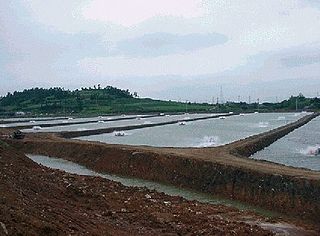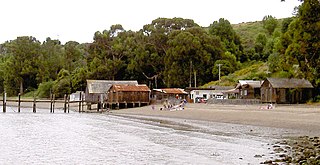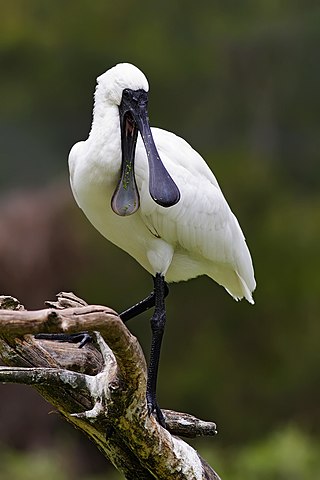
The Caridea, commonly known as caridean shrimp or true shrimp, from the Greek word καρίς, καρίδος, are an infraorder of shrimp within the order Decapoda. This infraorder contains all species of true shrimp. They are found widely around the world in both fresh and salt water. Many other animals with similar names – such as the mud shrimp of Axiidea and the boxer shrimp of Stenopodidea – are not true shrimp, but many have evolved features similar to true shrimp.

Waukesha is the county seat of Waukesha County, Wisconsin, United States, along the Fox River. Its population was 71,158 at the 2020 census, making it the seventh-most populous city in Wisconsin. It is part of the Milwaukee metropolitan area. The city is adjacent to the Village of Waukesha.

Mantis shrimp are carnivorous marine crustaceans of the order Stomatopoda. Stomatopods branched off from other members of the class Malacostraca around 340 million years ago. Mantis shrimp typically grow to around 10 cm (3.9 in) in length, while a few can reach up to 38 cm (15 in). A mantis shrimp's carapace covers only the rear part of the head and the first four segments of the thorax. Varieties range in colour from shades of brown to vivid colours, with more than 520 species of mantis shrimp known. They are among the most important predators in many shallow, tropical and subtropical marine habitats. However, despite being common, they are poorly understood, as many species spend most of their lives sheltering in burrows and holes.

Universal Orlando Resort, often shortened to Universal Orlando, is a 1,291-acre (522 ha) theme park and entertainment resort complex located in Orlando, Florida. Following the opening of Universal Studios Florida in 1990, MCA moved forward with plans to expand from a single park into a large resort hoping to compete with Walt Disney World. In 1999, a second theme park called Universal Islands of Adventure opened in addition to Universal CityWalk, a shopping promenade and nightlife district that incorporates a variety of themed hotels, restaurants, and retail outlets. A third park, 30-acre (12 ha) water park Universal Volcano Bay, was added in 2017, and a fourth theme park, Universal Epic Universe, is scheduled to open in 2025.
The Macy's Thanksgiving Day Parade is an annual parade in New York City presented by the U.S.-based department store chain Macy's. The Parade first took place in 1924, tying it for the second-oldest Thanksgiving parade in the United States with America's Thanksgiving Parade in Detroit. The three-hour parade is held in Manhattan, ending outside Macy's Herald Square, and takes place from 9:00 a.m. to 12:00 p.m. Eastern Standard Time on Thanksgiving Day, and has been televised nationally on NBC since 1953.

Marine shrimp farming is an aquaculture business for the cultivation of marine shrimp or prawns for human consumption. Although traditional shrimp farming has been carried out in Asia for centuries, large-scale commercial shrimp farming began in the 1970s, and production grew steeply, particularly to match the market demands of the United States, Japan and Western Europe. The total global production of farmed shrimp reached more than 1.6 million tonnes in 2003, representing a value of nearly 9 billion U.S. dollars. About 75% of farmed shrimp is produced in Asia, in particular in China and Thailand. The other 25% is produced mainly in Latin America, where Brazil, Ecuador, and Mexico are the largest producers. The largest exporting nation is India.

A freshwater prawn farm is an aquaculture business designed to raise and produce freshwater prawns or shrimp1 for human consumption. Freshwater prawn farming shares many characteristics with, and many of the same problems as, marine shrimp farming. Unique problems are introduced by the developmental life cycle of the main species.
White spot syndrome (WSS) is a viral infection of penaeid shrimp. The disease is highly lethal and contagious, killing shrimp quickly. Outbreaks of this disease have wiped out the entire populations of many shrimp farms within a few days, in places throughout the world.

Macrobrachium rosenbergii, also known as the giant river prawn or giant freshwater prawn, is a commercially important species of palaemonid freshwater prawn. It is found throughout the tropical and subtropical areas of the Indo-Pacific region, from India to Southeast Asia and Northern Australia. The giant freshwater prawn has also been introduced to parts of Africa, Thailand, China, Japan, New Zealand, the Americas, and the Caribbean. It is one of the biggest freshwater prawns in the world, and is widely cultivated in several countries for food. While M. rosenbergii is considered a freshwater species, the larval stage of the animal depends on brackish water. Once the individual shrimp has grown beyond the planktonic stage and becomes a juvenile, it lives entirely in fresh water.

China Camp State Park is a state park in Marin County, California, surrounding a historic Chinese American shrimp-fishing village and a salt marsh. The park is located in San Rafael, California, on the shore of San Pablo Bay. It is known for its hiking and mountain biking trails, scenic views, and open spaces. The 1,514-acre (613 ha) park was established in 1976. A 75-acre (30 ha) district, including the shrimping village and a prehistoric shell midden, were added to the National Register of Historic Places in 1979 for having state-level significance in archaeology, architecture, commerce, settlement, and social history. China Camp State Park, along with the Rush Ranch Open Space Preserve, is part of the San Francisco Bay National Estuarine Research Reserve.

The royal spoonbill also known as the black-billed spoonbill, occurs in intertidal flats and shallows of fresh and saltwater wetlands in Australia, New Zealand, Indonesia, Papua New Guinea, and the Solomon Islands. It has also been recorded as a vagrant in New Caledonia. The royal spoonbill lives in wetlands and feeds on crustaceans, fish and small insects by sweeping its bill from side to side. It always flies with its head extended. Widespread throughout its large range, the royal spoonbill is evaluated as Least Concern on the IUCN Red List of Threatened Species.

The Gulf of Mexico is an ocean basin and a marginal sea of the Atlantic Ocean, mostly surrounded by the North American continent. It is bounded on the northeast, north and northwest by the Gulf Coast of the United States; on the southwest and south by the Mexican states of Tamaulipas, Veracruz, Tabasco, Campeche, Yucatán, and Quintana Roo; and on the southeast by Cuba. The Southern U.S. states of Texas, Louisiana, Mississippi, Alabama, and Florida, which border the gulf on the north, are often referred to as the "Third Coast" of the United States.

The harborseal, also known as the common seal, is a true seal found along temperate and Arctic marine coastlines of the Northern Hemisphere. The most widely distributed species of pinniped, they are found in coastal waters of the northern Atlantic and Pacific oceans, Baltic and North seas.

Macrobrachium is a genus of freshwater prawns or shrimps characterised by the extreme enlargement of the second pair of pereiopods, at least in the male.

Macrobrachium carcinus is a species of fresh water shrimp known as the big claw river shrimp. It is native to streams, rivers and creeks from Florida to southern Brazil. It is the largest known species of Neotropical freshwater prawn, growing up to 30 centimetres (12 in) long and weighing as much as 850 grams (30 oz), although even larger specimens have been reported. It is an important species for commercial fishing in the Sao Francisco River basin, where it is known by the local name of pitu. M. carcinus is omnivorous, with a diet consisting of molluscs, small fish, algae, leaf litter and insects.

Eyestalk ablation is the removal of one (unilateral) or both (bilateral) eyestalks from a crustacean. It is routinely practiced on female shrimps in almost every marine shrimp maturation or reproduction facility in the world, both research and commercial. The aim of ablation under these circumstances is to stimulate the female shrimp to develop mature ovaries and spawn.

Kayamkulam Kayal, Kayamkulam Lake or Kayamkulam Estuary is a shallow brackish water lagoon stretching between Panmana and Karthikapally. It has an outlet to the Arabian sea at Kayamkulam barrage. The Kayal used to be connected to the sea most of the time except during dry season when a bar like formation separates it from the sea. Now the bar has been opened up permanently for construction of Kayamkulam Fishing Harbor. Kayamkulam boat race is conducted in Kayamkulam Kayal. Kayamkulam Kayal is the third largest back water or kayal in Kerala.

Marine Parade MRT station is an underground Mass Rapid Transit (MRT) station on the Thomson–East Coast line (TEL) in Marine Parade, Singapore. Located underneath Marine Parade Road, the station serves nearby residential and commercial developments including Parkway Parade, Roxy Square and I12 Katong.

Feeder shrimp, ghost shrimp, glass shrimp, grass shrimp, river shrimp or feeder prawns are generic names applied to inexpensive small, typically with a length of 1 to 3 cm, semi-transparent crustaceans commonly sold and fed as live prey to larger more aggressive fishes kept in aquariums.

Macrobrachium scabriculum is a species of freshwater shrimp. It is distributed in countries and territories around the Indian Ocean. It is known as Goda River prawn. The total length of male prawns become about 6.5 cm long and in females it is about 5 cm. A kind of fur develop on the chelipeds of males. Eggs produced by M. scabriculum are smaller in size, brownish in color, elliptical or oval in shape and hatched larvae undergone migration to low saline water for completion its life cycle.
















